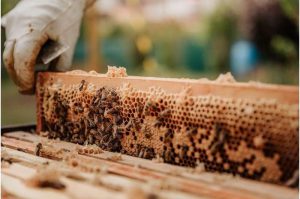Environment: Honey bees provide a snapshot of city landscape and health

Managed honey bees. Credit: Bianca Ackermann, public domain
Urban honey bees could be used to gain insight into the microbiome of the cities in which they forage, which can potentially provide information on both hive and human health, reports a study published in Environmental Microbiome.
Cities are built for human habitation, but are also spaces that host a wide range of living species, and understanding this diverse landscape is important for urban planning and human health. However, sampling the microbial landscape in a manner to cover wide areas of a city can be labor-intensive.
Elizabeth Hénaff and colleagues investigated the potential of honey bees (Apis mellifera) to help gather samples of microorganisms across cities, as honey bees are known to forage daily up to one mile from their hives in urban environments. They sampled various materials from three hives in New York as part of a pilot study, and found diverse genetic information, including from environmental bacteria, in the debris accumulated at the bottom of the hives. Subsequent samples of hive debris in Sydney and Melbourne (Australia), Venice (Italy), and Tokyo (Japan) suggest that each location has a unique genetic signature as seen by honey bees.
In Venice, the genetic data was dominated by fungi related to wood rot and date palm DNA. In Melbourne, the sample was dominated by eucalyptus DNA, while the sample from Sydney showed little plant DNA but contained genetic data from a bacteria species that degrades rubber (Gordonia polyisoprenivorans). Tokyo samples included plant DNA from Lotus and wild soybean, as well as the soy sauce fermenting yeast Zygosaccharomyces rouxii. Additionally, the authors compiled genetic material from the hive debris for Rickettsia felis (“cat scratch fever”), a pathogen that is spread to humans via cat scratches. These findings indicate the potential of this as a surveillance method but are currently too preliminary to suggest that this is an effective method of monitoring human diseases.
The hive debris also contained bee-related microorganisms, likely coming from honey bee parts present in the debris. Based on 33 samples from the hives across the subsequent four cities, the authors found known bee microorganisms, whose presence indicate a healthy hive, and in some hives bee pathogens were detected, such as Paenibacillus larvae , Melissococcus plutonius, or the parasite Varroa destructor. The authors suggest these findings indicate that debris may additionally be used to assess the overall health of the hives.
The authors conclude that honey bee hive debris collected by honey bees provides a snapshot of the microbial landscape of urban environments and could be used alongside other measures to assess the microbial diversity and health of cities and honey bees in turn.
More information: Elizabeth Hénaff, Holobiont Urbanism: sampling urban beehives reveals cities’ metagenomes, Environmental Microbiome (2023). DOI: 10.1186/s40793-023-00467-z. www.biomedcentral.com/articles … 6/s40793-023-00467-z
Provided by BioMed Central
We are here to share current happenings in the bee industry. Bee Culture gathers and shares articles published by outside sources. For more information about this specific article, please visit the original publish source: https://www.labmanager.com/ebooks/assays-reagents-and-antibodies-29356








